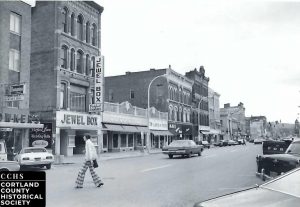But let us start at the beginning: The first owner that we can attribute to the home is Tercius Eels, a private in the War of 1812, Cortland’s Poor Master in 1831, and additionally active as postmaster, Whig leader, Town Clerk, and as a merchant.
Eels sold to Oren Stimson, who served as County Clerk and kept a dry goods store.
Harmon S. Conger bought of Stimson the house in 1851. Conger was a lawyer, politician, merchant, and editor of The Cortland County Whig and was involved in a scandal that will be covered more extensively in the post on 16 Main Street!
Conger sold the residence to Mandelbert Canfield in 1855, and the next year Canfield sold to John L. Burst. “Then in 1857, Mr. Burst sold to Caroline Blodgett. There was romance somewhere or somehow, for on February 25, 1858, John L. Burst and Caroline A., his wife, sold to Mr. Keator, and that ended the chain of transfers until the property left the Keator family by the sale in 1936,” (Cortland Democrat, May 7, 1937).
Thomas Keator moved with his family from Roxbury, NY to Cortland in 1854 and purchased the house in 1860. Mr. Keator was the first president of the First National Bank, a position in which he was succeeded by his son, Samuel, and later by another son, Edward Keator. His daughter, Mary K., married William F. Chadbourne who was a traveling salesman for New York silk importers, so the couple spent much of their time in New York City. In 1890, after William’s retirement the Chadbourne’s moved into Mary’s family home, where she remained until her death in 1936. The old house was demolished on March 4, 1937.
Construction on the new W.T. Grant building was funded by Boston investor Hyman E. Cline for $65,000. The W.T. Grant “5-and-10” chain had a long-term lease until the early 60s when the store moved to the Groton Avenue Shopping Center.
The structure is an example of the one-story commercial architecture that became popular in the 1920s and 30s with the widespread use of the automobile. Instead of shops, offices, and apartments above stores in one central downtown location serviced by mass transit (trolleys) or easily reached on foot, cities now spread out as people came to depend on the car. The one-story commercial building, like the one-story suburban house, became fashionable.
Other businesses showing up in city directories:
1965- Good Friends ladies’ clothing
1970- Rite-Aid Health Center
1975- Love of Pete gift shop; Barbara Moss clothing store
Also, the Hallmark store.
The building is now part of the McNeil campus, and the façade most recently underwent renovations in 2017.




